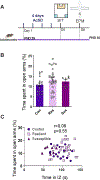Gains and Losses: Resilience to Social Defeat Stress in Adolescent Female Mice
- PMID: 37355003
- PMCID: PMC10996362
- DOI: 10.1016/j.biopsych.2023.06.014
Gains and Losses: Resilience to Social Defeat Stress in Adolescent Female Mice
Abstract
Background: Adolescence is a unique period of psychosocial growth during which social adversity can negatively influence mental health trajectories. Understanding how adolescent social stress impacts males and females and why some individuals are particularly affected is becoming increasingly urgent. Social defeat stress models for adolescent male mice have been effective in reproducing some physical/psychological aspects of bullying. Designing a model suitable for females has proven challenging.
Methods: We report a version of the adolescent male accelerated social defeat stress (AcSD) paradigm adapted for females. Early adolescent C57BL/6J female mice (N = 107) were exposed to our modified AcSD procedure twice a day for 4 days and categorized as resilient or susceptible based on a social interaction test 24 hours later. Mice were then assessed for changes in Netrin-1/DCC guidance cue expression in dopamine systems, for inhibitory control in adulthood using the Go/No-Go task, or for alterations in dopamine connectivity organization in the matured prefrontal cortex.
Results: Most adolescent females showed protection against stress-induced social avoidance, but in adulthood, these resilient females developed inhibitory control deficits and showed diminution of prefrontal cortex presynaptic dopamine sites. Female mice classified as susceptible were protected against cognitive and dopaminergic alterations. AcSD did not alter Netrin-1/DCC in early adolescent females, contrary to previous findings with males.
Conclusions: Preserving prosocial behavior in adolescent females may be important for survival advantage but seems to come at the price of developing persistent cognitive and dopamine deficiencies. The female AcSD paradigm produced findings comparable to those found in males, allowing mechanistic investigation in both sexes.
Keywords: Adolescent critical period; Guidance cues; Inhibitory control; Prefrontal cortex; Sex differences; Social defeat stress.
Copyright © 2023 Society of Biological Psychiatry. Published by Elsevier Inc. All rights reserved.
Conflict of interest statement
The authors report no biomedical financial interests or potential conflicts of interest.
Figures






Similar articles
-
Prescription of Controlled Substances: Benefits and Risks.2025 Jul 6. In: StatPearls [Internet]. Treasure Island (FL): StatPearls Publishing; 2025 Jan–. 2025 Jul 6. In: StatPearls [Internet]. Treasure Island (FL): StatPearls Publishing; 2025 Jan–. PMID: 30726003 Free Books & Documents.
-
The Black Book of Psychotropic Dosing and Monitoring.Psychopharmacol Bull. 2024 Jul 8;54(3):8-59. Psychopharmacol Bull. 2024. PMID: 38993656 Free PMC article. Review.
-
Unique effects of social defeat stress in adolescent male mice on the Netrin-1/DCC pathway, prefrontal cortex dopamine and cognition (Social stress in adolescent vs. adult male mice).eNeuro. 2021 Feb 12;8(2):ENEURO.0045-21.2021. doi: 10.1523/ENEURO.0045-21.2021. Online ahead of print. eNeuro. 2021. PMID: 33619036 Free PMC article.
-
Sexual Harassment and Prevention Training.2024 Mar 29. In: StatPearls [Internet]. Treasure Island (FL): StatPearls Publishing; 2025 Jan–. 2024 Mar 29. In: StatPearls [Internet]. Treasure Island (FL): StatPearls Publishing; 2025 Jan–. PMID: 36508513 Free Books & Documents.
-
Ornithine Transcarbamylase Deficiency.2013 Aug 29 [updated 2022 May 26]. In: Adam MP, Feldman J, Mirzaa GM, Pagon RA, Wallace SE, Amemiya A, editors. GeneReviews® [Internet]. Seattle (WA): University of Washington, Seattle; 1993–2025. 2013 Aug 29 [updated 2022 May 26]. In: Adam MP, Feldman J, Mirzaa GM, Pagon RA, Wallace SE, Amemiya A, editors. GeneReviews® [Internet]. Seattle (WA): University of Washington, Seattle; 1993–2025. PMID: 24006547 Free Books & Documents. Review.
Cited by
-
Chronic Adolescent Restraint Stress Downregulates miRNA-200a Expression in Male and Female C57BL/6J and BALB/cJ Mice.Genes (Basel). 2024 Jul 3;15(7):873. doi: 10.3390/genes15070873. Genes (Basel). 2024. PMID: 39062652 Free PMC article.
-
Effects of Ketogenic Diet on Increased Ethanol Consumption Induced by Social Stress in Female Mice.Nutrients. 2024 Aug 23;16(17):2814. doi: 10.3390/nu16172814. Nutrients. 2024. PMID: 39275131 Free PMC article.
-
Male and female mice may respectively form stronger social aversive memories with same and different sex conspecifics.bioRxiv [Preprint]. 2025 Jun 12:2024.08.12.607663. doi: 10.1101/2024.08.12.607663. bioRxiv. 2025. PMID: 39185229 Free PMC article. Preprint.
-
Neurobiology of resilience to early life stress.Neuropsychopharmacology. 2025 Jun 25. doi: 10.1038/s41386-025-02158-4. Online ahead of print. Neuropsychopharmacology. 2025. PMID: 40562842 Review.
-
Maternal behavior promotes resilience to adolescent stress in mice through a microglia-neuron axis.Nat Commun. 2025 Mar 8;16(1):2333. doi: 10.1038/s41467-025-57810-w. Nat Commun. 2025. PMID: 40057602 Free PMC article.
References
-
- Blakemore SJ, Robbins TW (2012): Decision-making in the adolescent brain. Nat Neurosci 15:1184–1191. - PubMed
-
- Kessler RC, Berglund P, Demler O, Jin R, Merikangas KR, Walters EE (2005): Lifetime prevalence and age-of-onset distributions of DSM-IV disorders in the national comorbidity survey replication. Arch Gen Psychiatry 62:593–602. - PubMed
Publication types
MeSH terms
Substances
Grants and funding
LinkOut - more resources
Full Text Sources

